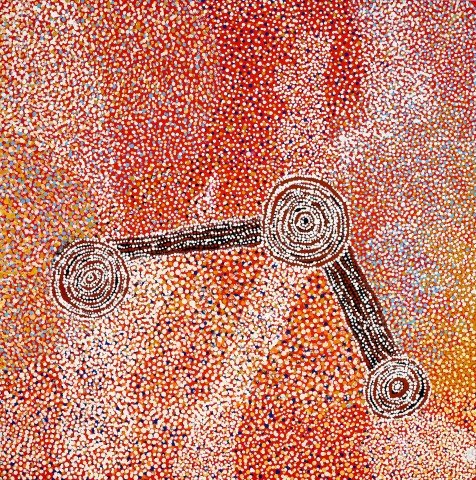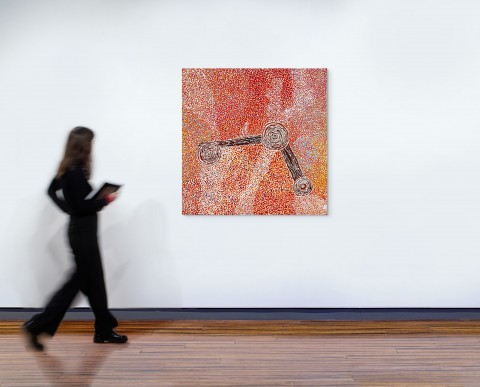ROCKHOLES AND COUNTRY NEAR THE OLGAS, 2007
BILL WHISKEY TJAPALTJARRI
synthetic polymer paint on linen
121.0 x 121.0 cm
bears inscription verso: artist’s name, size and Watiyawanu Artists cat. 03-07-253
Watiyawanu Artists of Amunturrungu, Mount Leibig, Northern Territory
Tony Bond, Adelaide
Private collection, Adelaide
After having watched the women at Amunturrungu (Mount Liebig) paint in the new ‘Watiyuwanu’ art centre for some time, in December 2004, aged 85, Bill Whiskey (Mindinderi) walked in one day, sat down and began to paint. His paintings, executed with an immediate and distinct authority, rapidly drew attention to him and granted him almost instant fame.
In the space of a few short years, he created an astonishing body of paintings that quickly entered major public and private collections, both nationally and abroad. In 2006, and again in 2007, he was also a finalist in the Telstra National Aboriginal and Torres Strait Islander Art Award.
Born around 1920 at Pirupa Akla (Olgas) in Pitjantatjara country, Whiskey eventually moved to the outstation of Amunturrungu with his wife, Colleen Nampitjinpa, where they both held prominent roles as Ngangari (traditional healers). There are stories that at night Whiskey would leave his body and fly over the landscape; upon his return he would report on what he had seen.
This painting describes events related to the story of the ancestral white cockatoo and her terrible battle to ward off the murderously amorous Crow, an event which took place near the artist's birthplace at the rock holes of Pirupa Alka (rock holes near the Olgas and Uluru.) The depiction of country is also associated with the journeys Whiskey made as a young man to Areyonga and Haasts Bluff. The variegated surface and mixed palette and the sheer scope of its recording of Country is handled with a virtuosic delicacy evocative of filigree, while the subtlety of the shifting rhythms is controlled on a monumental scale by the density and variety of dotting. The hovering roundels together with the heady use of colour (red, gold and ochre with an extensive overlay of white on a black ground) lend this work a shimmering radiance seen only a small number of the works he executed.
CRISPIN GUTTERIDGE

